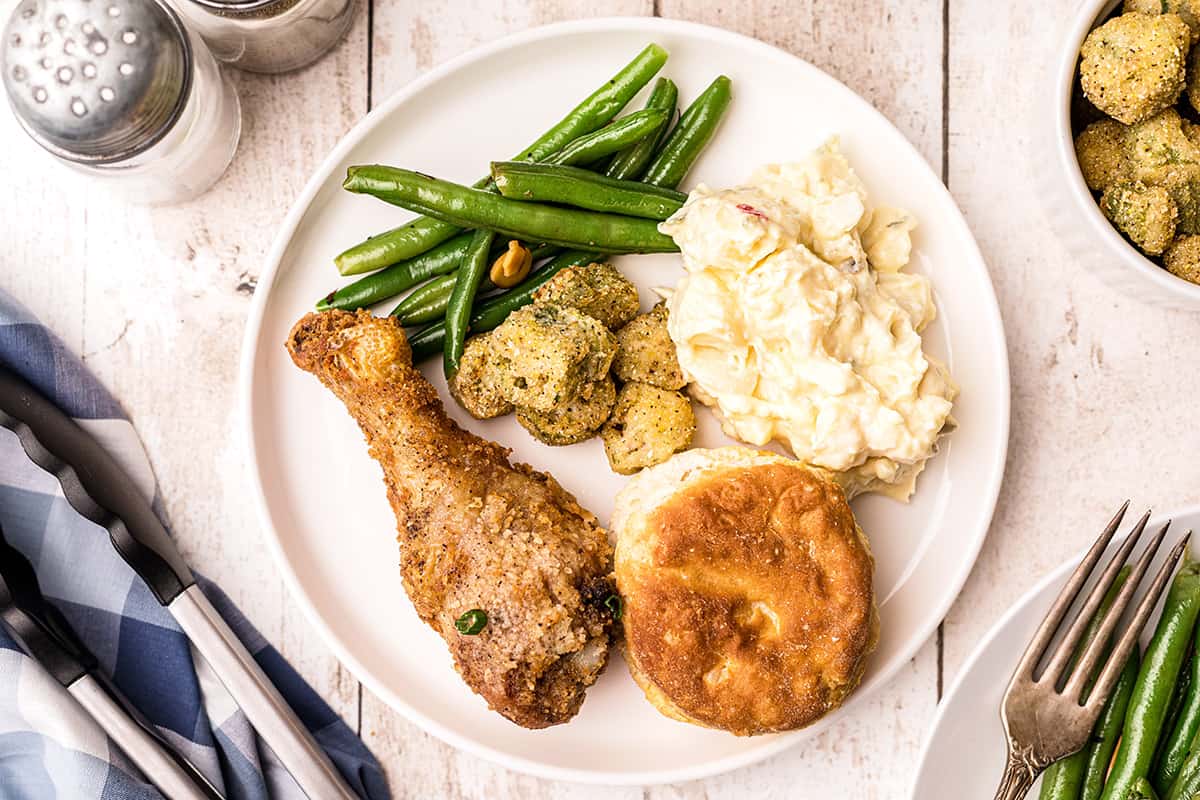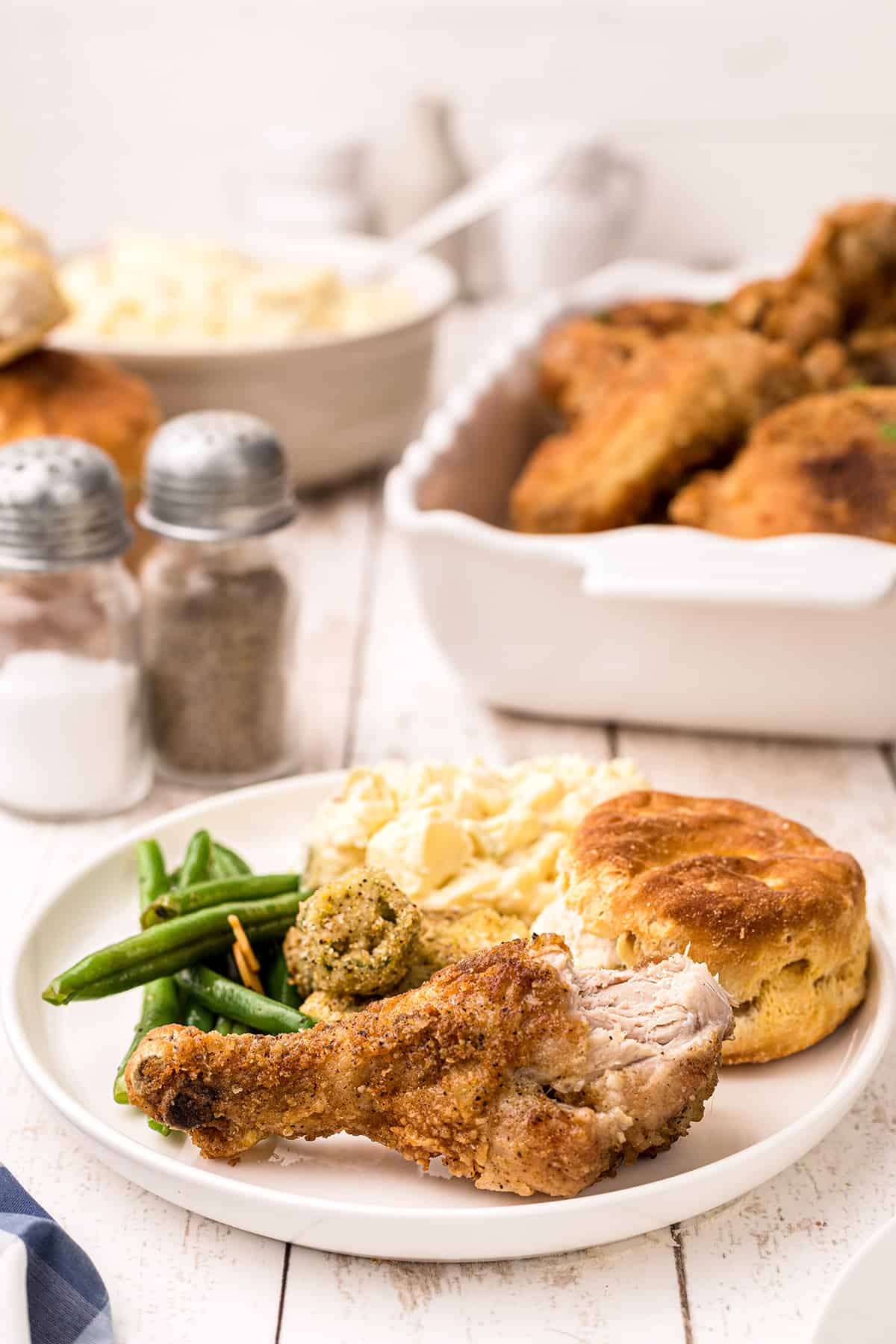Fried chicken is a classic comfort food that’s loved by many. The crispy, golden exterior covering the moist, flavorful meat is hard to resist! While you can easily grab fried chicken from a fast food joint, nothing beats homemade. Making fried chicken from scratch lets you control the ingredients so you can create the perfect flavor and texture.
I love whipping up fried chicken at home. Over the years, I’ve experimented with different techniques and recipes to land on a foolproof method for crisp, juicy chicken. In this article, I’ll share my tips on how to make great fried chicken along with a recipe for boneless chicken thighs. Let’s get cooking!
Tips for Making the Best Fried Chicken
Fried chicken might seem simple, but there are some key steps to follow for the ideal texture and taste Here are my essential tips
Choose the Right Chicken Pieces
For fried chicken, you want to use chicken pieces with bones and skin left on. The bones help the meat retain moisture while frying. Popular options are chicken thighs, drumsticks, wings, and split chicken breasts.
I prefer boneless, skin-on chicken thighs. Thighs have more fat and connective tissue than breasts, making them extra flavorful and tender when fried up. Going boneless makes them easier to eat.
Brine the Chicken
Before breading and frying, I always brine the chicken Brining, aka soaking in a saltwater solution, infuses the meat with moisture and seasoning This helps the chicken stay juicy when cooked.
My quick chicken brine contains salt, sugar, and aromatics like garlic, peppercorns, and thyme. After 30 minutes to an hour of brining, the chicken is ready to fry.
Use Buttermilk for the Wet Coating
Once brined the chicken needs a wet coating before the dry breading. Buttermilk is the perfect wet coating for fried chicken! The lactic acid tenderizes the meat while the milk proteins brown beautifully in the hot oil.
I soak brined chicken pieces in buttermilk for at least 20 minutes before dredging in the flour coating. This allows the buttermilk to really penetrate the meat.
Double Dredge in Flour
For the crispiest crust, dredge the buttermilk-coated chicken in flour not once, but twice. Dredging twice creates an extra thick and crunchy coating that stays put on the chicken.
I use all-purpose flour cut with some cornstarch for my dredging flour. The cornstarch crisps up nicely when fried. Some black pepper and spices add flavor to the crust.
Fry at the Right Temperature
The oil temperature is key for properly fried chicken. Too low, and the coating absorbs oil and turns greasy. Too high, and the outside burns before the inside cooks through.
I fry chicken at 350°F to 375°F for a crispy exterior that’s never greasy. Use a thermometer to monitor the temperature and adjust the heat as needed. The chicken is done when it reaches an internal temperature of 165°F.
Let It Rest Before Eating
Once golden brown and cooked through, remove the chicken from the oil and let it rest on a wire rack for 5-10 minutes before devouring. Resting allows moisture to redistribute so you get the ideal crispy crust with super moist meat.
Now let’s walk through an easy recipe for fried chicken bliss!
Buttermilk Fried Chicken Recipe
This recipe uses boneless, skin-on chicken thighs for convenient fried chicken you can eat with your hands. Brining keeps the meat tender and juicy, while buttermilk and double dredging deliver the perfect crunchy coating.
Ingredients
- 8 boneless, skin-on chicken thighs
- 1 quart cold water
- 1/4 cup kosher salt
- 3 tablespoons sugar
- 3 garlic cloves, smashed
- 1 tablespoon black peppercorns
- 2 sprigs fresh thyme
- 2 cups buttermilk
- 2 cups all-purpose flour
- 1/4 cup cornstarch
- 1 tablespoon paprika
- 2 teaspoons garlic powder
- Salt and pepper
- Peanut or vegetable oil for frying
Instructions
-
Make the brine: In a large bowl, combine the cold water, salt, sugar, smashed garlic cloves, peppercorns, and thyme sprigs. Whisk until the salt and sugar dissolve. Add the chicken thighs and refrigerate for 30 minutes to 1 hour.
-
Coat with buttermilk: Remove chicken from brine and discard brine. Pat chicken dry with paper towels. Place chicken in a bowl and cover with buttermilk. Refrigerate for 20-30 minutes.
-
Make the dredging flour: In a shallow bowl, whisk together the flour, cornstarch, paprika, garlic powder, 2 teaspoons salt, and 1 teaspoon black pepper.
-
Bread the chicken: One piece at a time, remove chicken from buttermilk, allowing excess to drip off. Dredge in the flour mixture, pressing to coat all over. Return to buttermilk, then dredge again in flour. Place breaded chicken on a plate.
-
Fry the chicken: Heat 1-2 inches oil in a large Dutch oven or deep skillet to 350-375°F. Working in batches, add chicken pieces skin-side down. Fry for 8-10 minutes, flipping halfway, until crisp and golden brown and meat registers 165°F. Drain on a wire rack.
-
Serve and enjoy! Let chicken rest for 5-10 minutes before serving. Perfect with mashed potatoes, mac and cheese, coleslaw or your favorite fried chicken sides!
So there you have it – my tips and recipe for killer homemade fried chicken. With the right techniques, ingredients, and some practice, you can fry up chicken with the best crunch and juiciness right in your own kitchen. Bust out the cast iron skillet and get crackin’ on this comfort food favorite. Your family and friends will be begging for more!

Storing and Reheating Leftovers
If you have any leftover fried chicken, you can keep it in the refrigerator for a day or two. It can be reheated in a 250-degree F oven for about 15 minutes or, even better, just let it come to room temperature and enjoy it without any heating at all.

Use the Right Pan and Oil
Using a well-seasoned iron skillet makes a huge difference in the taste of fried chicken. There’s just something about a great iron skillet that you can’t get from any other piece of kitchen equipment. The one I use for chicken is a 12-inch skillet that’s about 75 years old.
Also, I recommend frying chicken in peanut oil because it will withstand higher temperatures for a longer time without burning than other oils.
PRO TIP: Experts will tell you that the oil should be 375 degrees before frying and to try to maintain that temperature during the cooking. I learned to cook before everyone had kitchen thermometers, so I judge it my own way. My little trick to test whether the oil is hot enough to cook: Put the end of a wooden spoon in the skillet. If the oil bubbles around the handle, it’s hot enough.
If you try this fried chicken method once, I’ll bet you won’t go back to all that complicated marinating and shaking. It’ll be the crispiest, most flavorful chicken you’ve cooked in a long time, or my name isn’t Nana.
I’m not making any kind of promises about what the cleanup is like, however .

- If you like your chicken on the spicier side, try adding a teaspoon of cayenne pepper to the flour or sprinkle the chicken lightly with hot sauce before dredging it in the flour.
- Use Jane’s Krazy Mixed-Up Salt (or another seasoning salt) in place of the plain salt in the recipe.
- Lightly sprinkle the chicken pieces with a little garlic powder before placing them in the flour.
- You can use this method to cook whole cut-up chicken, boneless chicken breasts, chicken strips, or any pieces you like. I sometimes just cook all wings because they’re my favorite.
Fried Chicken
FAQ
What is the secret to making good fried chicken?
Don’t skip the brine.
But if you can plan ahead, make time to soak the poultry in a brine — a solution made from water, salt, and sugar—before you fry it. This will help deepen the flavor of the meat and keep moisture inside the chicken, resulting in a juicy, tender result.
What is the trick to getting crispy chicken?
Double Dredge – The best way to ensure the breading will stay on the chicken is to double down on the flour. This creates a super thick, extra crispy coating on your chicken. After dredging the chicken in seasoned flour, dip it into an egg wash and place it back into the flour.Sep 12, 2023
What makes fried chicken taste better?
Key Ingredients for Fried Chicken
Seasoning mixture: Make a flavorful seasoning mixture with smoked paprika, white pepper, garlic powder, ground ginger, celery salt, black pepper, ground mustard, dried thyme, dried basil, and dried oregano.
Do you do egg or flour first for fried chicken?
For frying chicken, you typically coat it in flour first, then egg, and then flour again (or breadcrumbs).
